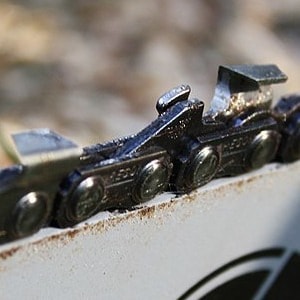 Today we are going to look at a chainsaw chain sizes chart. This article is going to detail how to measure the bar and chain of your chainsaw. We will start with the very basics.
Today we are going to look at a chainsaw chain sizes chart. This article is going to detail how to measure the bar and chain of your chainsaw. We will start with the very basics.
First of all, the bar is the long piece of metal that the chain wraps around. This is the part that sticks out of the body of the chainsaw, where the motor or the engine is. If you have an 18” chainsaw, it really means you have a chainsaw with an 18” bar on it.
Depending on what you are doing, you will require a different size of bar. A bigger chainsaw is going to need a bigger bar. You can’t cut through a massive tree with a small 12-inch bar and chain. On the other side, most small cordless chainsaws will come with a bar somewhere between 10 inches and 12 inches.
Not every chainsaw will work with every size of bar. Some may allow you to upgrade one size up or downgrade one size down. For example, many medium chainsaws that come with an 18-inch bar will allow you to go up to a 20 or down to a 16.
How to Measure the Bar of Your Chainsaw
If you have a chainsaw already but are unsure of the size or unsure how to measure it, just follow these simple steps. You need to measure the usable length of the entire bar. This is also referred to as the cutting length of the bar. To measure how long your bar is, simply place a measuring tape at the base of the chainsaw where the bar begins and measure to the end. It is very simple.
Of course, you will probably need to round the number up to the nearest even measurement. For example, if the bar only measured 18.5”, it is going to be in fact 20”.
Read More: How To Tighten Chainsaw Chain – Beginner’s Guide
How to Measure Your Chainsaw Chain
 Measuring your chainsaw chain will only take a few minutes. Once you have the chain off of the chainsaw, all you need to do is discover the pitch and the gauge, and you can do this easily with a piece of tape, a quarter, a penny, and a dime.
Measuring your chainsaw chain will only take a few minutes. Once you have the chain off of the chainsaw, all you need to do is discover the pitch and the gauge, and you can do this easily with a piece of tape, a quarter, a penny, and a dime.
We will start with the pitch, which is the size of the chain itself. The pitch is going to be the distance between the drive links of the chain. To figure out what the pitch is, simply measure the exact distance between any three rivets, then divide by two. The rivets are the small, circular studs that hold the individual chain segments together. Measure from the center of one rivet to the center of the third rivet, then divide.
The most common chain pitches are either 3/8” or .325”.
Next, you need to discover the chain gauge. There is a professional trick to doing this, and it is where your three coins will come in handy. Simply clean one of the grooves so it is free of debris and then jam each coin inside the groove one at a time. The chainsaw groove is the hollow space where the bar would go into. You can’t miss it.
Depending on which coin fits perfectly, that is your gauge size. Don’t forget to use a U.S. coin.
- Dime: .050 Gauge
- Penny: .058 Gauge
- Quarter: .063 Gauge
As a side note, there is probably an easier way to do this. If you look closely at the bar of your chainsaw, it undoubtedly has all of the information printed on it. You will see a stamp near where the bar locks into the guts of the chainsaw.
It will say something like 3/8” 72 1.3mm/.050”. This means your chain is 3/8” pitch, .050 gauge, and that it has 72 drive links. To get a replacement chainsaw, this is all the information you will need. Take these numbers, the length of the bar, the pitch, the gauge, and the number of drive links of the chain, and you can easily get a new replacement at any hardware store.
Read More: How To Measure A Chainsaw Bar – All You Need To Know
How a Chainsaw Chain Works
If you are curious about how the actual chain works to cut wood, here is some fun information. There are four main aspects of how this small and thin chain manages to cut down entire trees with incredible ease.
The chain cuts wood using the cutter. These are the teeth of the chain that actually bite into the wood to cut it. As the chain is spinning, the cutters are facing forward to bite through the wood. Once the chainsaw touches the wood, these tiny little claws take small bites out of the wood until they’ve cut through the entire thing. Think of it like taking little bites out of a long piece of corn.
The only difference here is they are spinning tremendously fast, and so they quickly eat through any log or branch,
Types of Chainsaw Chains
 There are three main types of chains for chainsaws. Each one has an aggressiveness level that depends on what exactly you are using it for.
There are three main types of chains for chainsaws. Each one has an aggressiveness level that depends on what exactly you are using it for.
There is an anti-kickback chain, which is the most common chain. These are found on almost all normal and residential chainsaws. This chain is designed to be as smooth as possible and to give the least amount of kickback to the operator. It does this by reducing how much wood the chainsaw can cut in a single rotation. There are lots of cutters on the chain to make the operation slow but smooth.
Skip-tooth chains are medium. These are used by professional woodcutters and have a space between each cutter – basically, fewer teeth. This gives the chain a better rate of cutting but reduces how smooth the cutting is, meaning there is more kickback than with a low-level chain.
Then there is the full-skip chain. These are extremely aggressive chains that can work through wood quickly. There are massive spaces between each cutting tooth, making it like hacking through wood with an ultra-fast hatchet. These types of chains are only used on really big chainsaws. They definitely cut the fastest, but they take a skilled hand to operate.
Read More: Chainsaw Chain Types – A Thorough Guide

